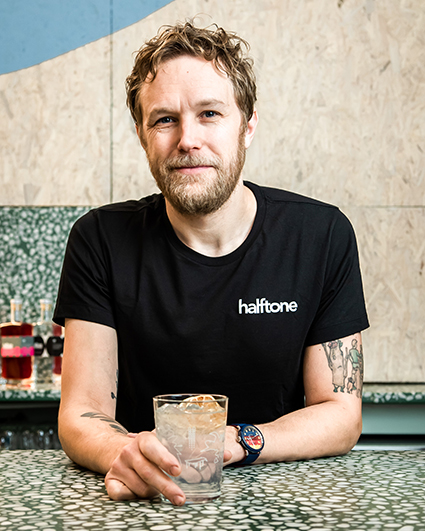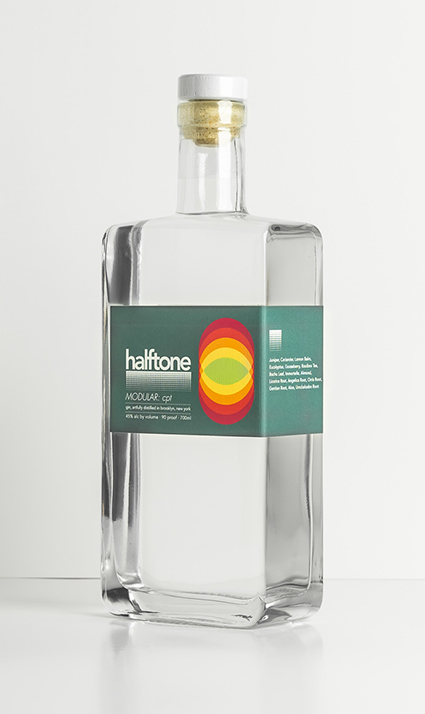Brooklyn defines culture. Music, cinema, beer, spirits, the New York borough births trends. So with the craft spirits movement on the rise, it shouldn’t be surprising to find one of its brightest stars tucked down a side street in Gowanus. Still, Halftone Spirits will catch you off guard.
Halftone, a term that comes from the printing industry, differentiates itself by approach and attitude. It layers flavors like colors, creating gins that burst of turquoise and pink, bold magenta, or earthy oranges and yellows. This is most apparent in the distillery’s Modular series, our favorite of which is the Cape Town influenced Modular: CPT.
In this edition of Bottle Breakdown, we sat down with Halftone Spirits Distiller + Owner Andrew Thomas to learn more about the distillery, what goes into every bottle of his Modular: CPT, and what we should pair with it.

Spirited: What’s the story behind Halftone Spirits?
Andrew Thomas: Halftone Spirits is the brainchild of head distiller Andrew Said Thomas and partners Basil Lee and Kevin Stafford. The trio met as Brooklyn homebrewers in 2009, and while Lee and Stafford went on to found Finback Brewery, Thomas began finding success distilling at home and developing a culinary approach to crafting gin. The three went about finding a space that could house both a second brewery and a cocktail tasting room, and found the perfect location in Gowanus Brooklyn. The space welcomes beer aficionados and cocktail enthusiasts alike. We are a botanically driven distillery and we have released 12 unique gins, an aquavit, and a vodka in the 2.5 years since we opened. As a distiller, I enjoy the challenge of sourcing new botanicals and finding how to harmonize those flavors into a balanced spirit. The idea of Halftone comes from the printing industry, where printers layer different colors atop one another to make a composite image. When I create a new gin, I layer flavors and aromas atop each other to make a singular experience.
Spirited: Why do you feel that Brooklyn is a worthwhile place to make gin and how does that ethos make it into the spirits you’re producing?
AT: We operate with a New York State Farm Distiller’s licence which allows us to operate a tasting room, self distribute in the state, and also sell to other alcohol makers with a Farm License, such as farm breweries, wineries, and cider makers. Having access to so many accounts within New York City has allowed us to grow while still keeping our distribution footprint fairly modest (though we are expanding up the Hudson River and looking at distributing to neighboring states.) More specifically, Brooklyn is such a hugely multicultural place, and I love seeing how our gin is incorporated by different bars and restaurants. We have accounts at Spanish, Korean, Malaysian Restaurants, and Tiki bars, and they all put their own spin on our spirits, and that’s exciting and inspiring. As much as I love tinkering with botanicals in the distillery, ultimately I want to offer mixologists new tools to expand their menus.
Spirited: The Halftone Modular: CPT gin is so unique. It’s filled with botanicals from Africa that you rarely see anywhere else. What exactly is in each bottle and how do you get your botanicals?
AT: CPT is probably my favorite gin recipe to date as it uses botanicals I’ve never seen employed in a spirit. I started looking into what botanicals I could source in the US, and when I was able to locate buchu leaf, I felt I was on to something special. Buchu leaf is commonly used in tea, and has a rich aroma of peppermint and pine. I wanted to use fynbos, which is a plant that grows across the Western Cape Province and has this overwhelming eucalyptus aroma. It just perfumes the air when you’re outside the city. Unfortunately fynbos is not FDA approved, so I ended up using traditional eucalyptus leaf. To balance those strong aromas, I used dried Cape Gooseberries, which are tart, yellow berries that taste somewhere between a cranberry and starfruit. Other botanicals from the region include aloe, immortelle flowers which smell like turmeric and chicken stock, and lastly umckaloabo root which is an African geranium. These all rest on a bed of traditional gin botanicals which include coriander, angelica root, and of course juniper.

Spirited: Can you tell us a bit about why you wanted to make this gin?
AT: Having spent a fair amount of time in Cape Town, South Africa, and having enjoyed some great local gins down there, I really wanted to craft an homage to the region. The range of flavors and aromas used in their cuisine are quite unknown in the US, and I was intrigued in how they would influence a spirit. Aroma is tied to memory, so I personally wanted a spirit to conjure some of the great times I had there.
Spirited: Let’s talk process. Yeast, fermentation, stills, distillation, etc. How do we go from ingredients to liquid?
AT: We source 95% ABV corn spirit from a bulk distillery in upstate New York. (As a Farm Distillery, we by law have to use 75% New York State ingredients.) Once we receive the Grain Neutral Spirit, I re-rectify it all in our 100 gallon, hybrid still. I do this for two reasons. First, we bottle the redistilled corn spirit as our vodka. But perhaps more importantly, I want to have as clean and as neutral of a base as possible for our gin. There’s no sense in crafting a spirit if it’s going to be corrupted by a base with off flavors or aromas. Depending on which spirit I’m making, I’ll mascertate- or soak- about 1/3 of the total juniper I’m using on neutral spirit, and in the case of CPT, all of the gooseberry for 2-3 days. The alcohol will breakdown the oils and flavor components over time and adhere to the alcohol molecules. I’ll then stain the botanicals off the spirit and start to heat up the liquid. Alcohol volitizes at 173ºF, whereas water boils at 212º. As distillers, we use this temperature difference to separate the alcohol from the remaining water. The alcohol vapors will pass through a “gin basket” which is basically a metal cylinder packed with the other botanicals we are using to flavor the spirit. So that’s where coriander, roots, flowers and the other dozen or so botanicals will be employed. The heat and the alcohol will unlock the essential oils in the botanicals, and they’ll fuse with the vapor. That vapor is then cooled back into a liquid and comes off the still around 140 proof. I taste the spirit as it comes off the still, and once I can taste the spirit becoming bitter, I cut off the run and store what is high proof gin. Over the course of the next 10 days I’ll do a “Slow Proofing” in which I’ll add a little bit of water each day to bring the ABV of the spirit from about 70% down to bottle strength, which is about 45% abv.
Spirited: On the nose, what are we looking for?
AT: The mintiness of buchu and eucalyptus is evident right when you uncork the bottle. But under that first impression there is a current of lemon, papaya, and rose flower, the latter of which comes from the use of orris and umckaloabo roots. It’s bright and inviting, and is nowhere near the pine bombs some gins favor.
Spirited: How about once it hits the palate and through the finish?
AT: What I love about this gin is how mercurial it is. That initial waft of mint on the nose is not evident when the spirit hits your tongue. Instead you get this incredible tropical fruit note. That’s entirely the gooseberry, which is far more tropical in its distilled form than when you eat the berries, which are quite tart. I use rooibos honeybush tea in this gin as well, which supports the fruitiness with a clover honey taste. And then the minty menthol nature of eucalyptus returns for a cooling finish. And zero burn. I can drink this as an aperitif every day.
Spirited: So CPT isn’t the first in Halftone’s Modular series. Can you tell us a bit about the origin of the series, what other bottles have you released in the series, and what might be coming down the pipe?
AT: One of my goals in starting Halftone was to really push the definition of gin. One of our most successful approaches to expanding that vocabulary is in the Modular series, which takes a global look at the spices used in local cuisines. The phrase “if it grows together it goes together” has always stuck with me, and has been a guiding light for this series. Our first iteration was Modular: HND, which is the airport code for Haneda Japan. HND incorporated green tea, yuzu, sesame seeds and shiso leaf. The second iteration was SVQ, the airport code for Seville, Spain. For that gin I wanted to make a very savory spirit that could work with tapas and complex vermouth. In addition to Spanish orange peel, SVQ highlights rosemary, thyme and a bit of sea kelp for a saline finish. Salt doesn’t vaporize, so I needed to find a way to get that “next-to-the-ocean-eating-fresh-seafood” element, and I found a beautifully aromatic dulse that cinched the recipe. CPT is the third in the series, and a favorite among the taproom staff. I’m beginning to outline our fourth destination and currently looking at the spices used in the West Indies, which has informed many rums but very few gins.
Spirited: What haven’t you told us that we should know?
AT: I hope people sip CPT and are surprised that it’s still gin, but unlike anything they’ve had before.
Spirited: When is the ideal time to enjoy Halftone Modular: CPT? And what’s your favorite way to enjoy it?
AT: I think if it’s chilled, it works as a great aperitif. It also mixes incredibly well in tiki drinks. I love rum, but if you substitute the CPT in pretty much any tiki drink, it will send it to the stratosphere.
Spirited: Is there a pairing you would recommend?
AT: Guava. When we were working on a cocktail to highlight CPT, guava was the perfect handshake.
Spirited: With so many gin options out there, why should we choose to drink Modular: CPT?
AT: The gin category is a crowded field, but many distilleries rely on a known set of botanicals. I can honestly say there is nothing like CPT on the market. If you want to taste the outer reaches of botanical spirits, there’s nothing better.



